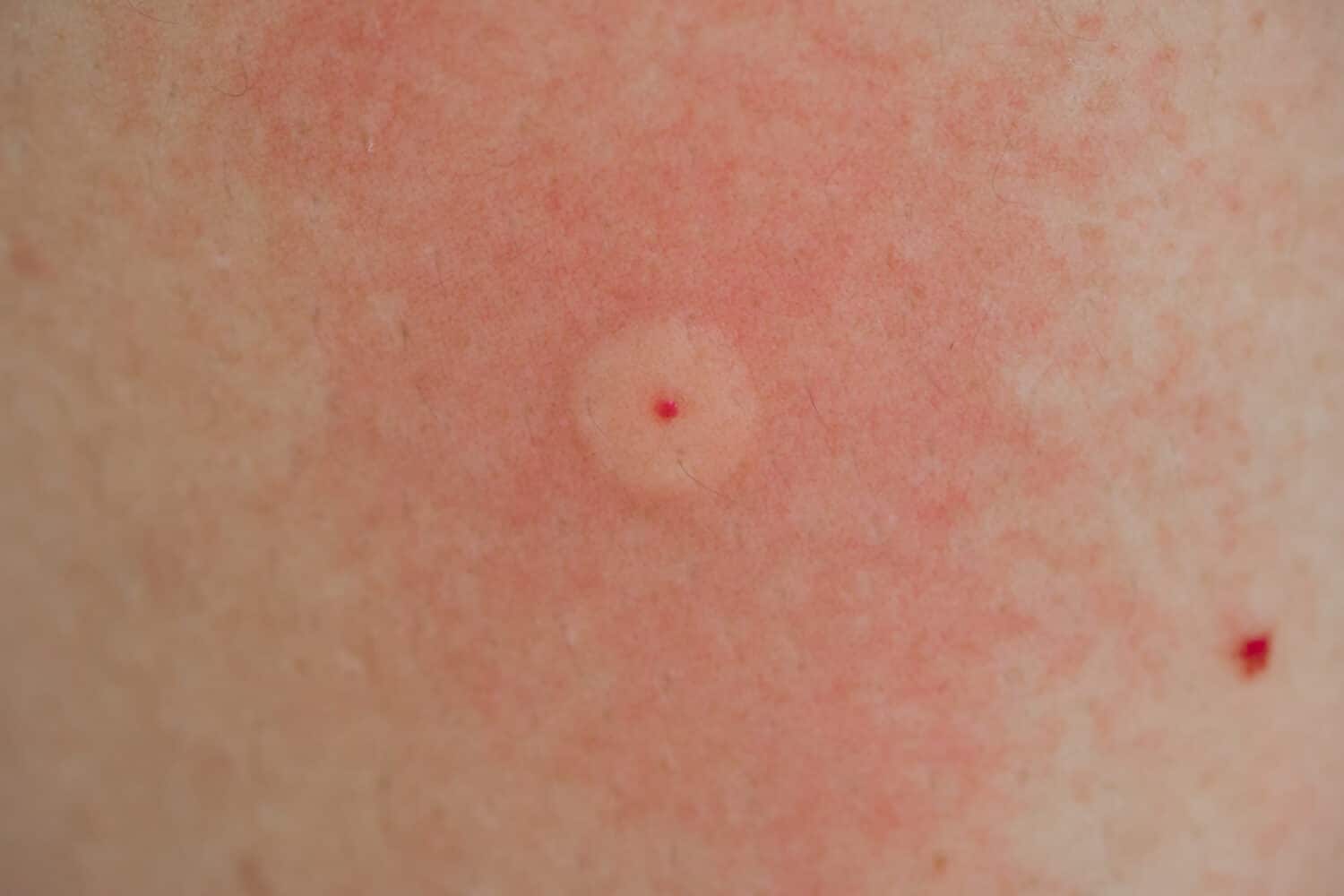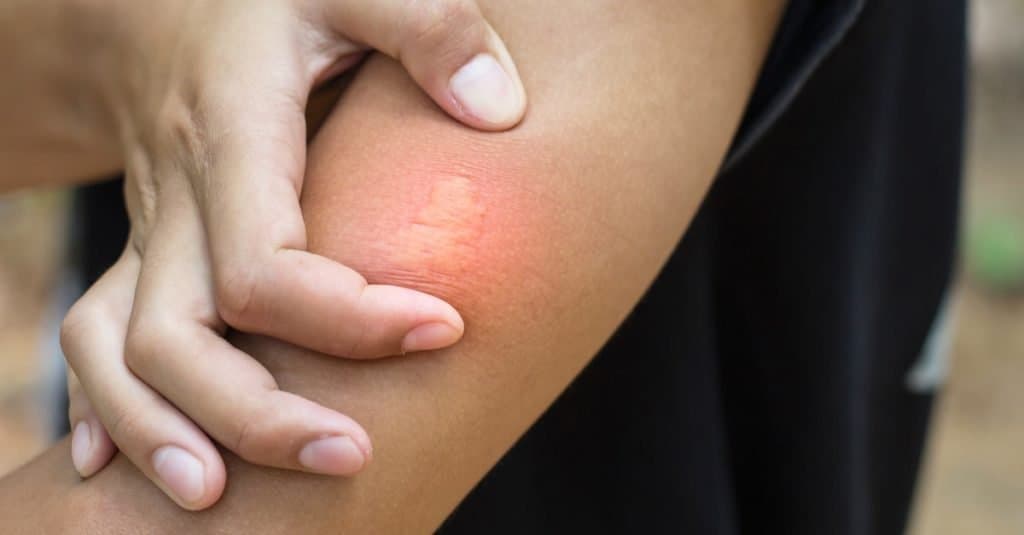Bee stings are common occurrences that anyone working or playing outside should probably be aware of. A good sting can hurt, but how can you tell if you’ve been stung by a bee or another insect? Also, what should you do to treat a bee sting? Let’s answer these questions and find out all we can about bee stings and their treatment.
Bee Stings: What They Look Like

A bee sting looks like a red inflamed area with a small white circle around the sting.
©kanoksak neamsum/Shutterstock.com
A bee sting is when a bee injects you with its venom from a stinger on its abdomen. The venom can be quite painful, especially for children, and will almost immediately cause red and swollen skin at the location of the sting.
With how the biology of a bee stinger works, sometimes the bee leaves its stinger in your skin as it continues to pump venom. The stinger will be a small black needle-like object with a small organ that pumps the venom and should be taken out quickly to stop the venom from spreading. You can check if the stinger is still in your skin by looking for a small black thing sticking out of the bump. It may have a round end, which is where the venom comes from. You can also stretch your skin around the stinger to see it better and pull it out.
You can tell if it was a bee or a wasp that stung you by looking for the stinger. Bees usually leave their stingers behind, but wasps do not. Wasps can sting you more than once, but bees can only sting you once. Wasp stings are also more likely to make you allergic than bee stings.
After a few minutes, the bee sting will look like a red bump with a white dot in the middle. It may also itch and continue to sting or ache. A bee sting feels like a sharp, burning pain when it happens. This pain is right away and can be mild or strong. Some people may also feel sick, dizzy, or faint after being stung, especially if they are allergic to bee venom.
Bee Stings: How to Treat

If you are allergic at all, further swelling and itching can occur locally and in other areas of the body.
©WIRACHAIPHOTO/Shutterstock.com
Most bee stings can be treated at home with simple steps. Here’s what you can do to ease the pain and swelling of a bee sting, provided you aren’t allergic. If you are allergic, please read an additional paragraph below:
- Remove the stinger as soon as you can. Use tweezers or your fingernail to scrape it off. Don’t squeeze the stinger or the venom sac, as this can release more venom into your skin.
- Wash the sting area with soap and water to prevent infection.
- Apply a cold pack or ice wrapped in a cloth to the sting area for 10 minutes at a time. This can help reduce inflammation and numb the pain.
- Use an over-the-counter cream or lotion to soothe the skin and relieve itching. You can try antihistamine creams, calamine lotion, hydrocortisone cream, or aloe vera gel.
- Take an oral antihistamine like Benadryl or a pain reliever like ibuprofen if needed. The antihistamine can help the reaction from spreading and itching, while the pain reliever can help the pain and swelling go down.
If you have a severe allergic reaction to a bee sting, you need emergency medical help immediately. Signs of an allergic reaction include:
- Trouble breathing or swallowing
- Swelling of your face, lips, tongue, or throat
- Hives or rashes on your skin
- Nausea, vomiting, or diarrhea
- Dizziness, fainting, or loss of consciousness
- Fast or irregular heartbeat
If you have an epinephrine auto-injector (such as EpiPen), use it as directed and call 911. If you don’t have one, ask someone to call 911 for you and stay with you until help arrives. Allergic reactions can be life-threatening and need immediate treatment and can have onset symptoms that occur extremely fast.
For people that know they are allergic to bees, keeping an EpiPen around the house is probably a good idea since you can’t totally control an accidental sting if you are outside in any capacity.
Bee Stings: Different Types of Stings

Wasps, ants, and other insects can also cause a painful sting.
©Wilfreda Wiseman/Shutterstock.com
There are a few types of bees that can potentially sting you, and they are all usually found in the same climates (although they each have unique nests and habits). Let’s go over some of the most common species that you could encounter and learn if they can sting you:
- Honeybees. These are the bees that make honey and live in large colonies. Honeybees have barbed stingers that get stuck in the skin and detach from their bodies. This means they can only sting once but also release a chemical signal that attracts more bees to sting.
- Bumblebees. These are fuzzy bees that are usually black and yellow. They live in smaller colonies than honeybees and nest in the ground or in cavities. Bumblebees have smooth stingers that can be used multiple times but are not very aggressive and rarely sting.
- Carpenter bees. These are large, black bees that bore holes in wood to make their nests. They look similar to bumblebees, but have shiny abdomens. Only the females have stingers, but they are very docile and rarely sting.
OUCH! Just because something stung you doesn’t necessarily mean it was a bee! The most common culprits of stings will usually be wasps, hornets, and fire ants. Here are a few of the more common ones, plus a little about their stinging habits:
- Wasps. These are slender insects that have narrow waists and long legs. They can be yellow, black, red, or metallic in color. They build paper-like nests in trees, eaves, or underground. Wasps have smooth stingers that can be used multiple times, and they can be very aggressive and territorial.
- Hornets. These are a type of wasp that are larger and more robust than other wasps. They can be black and white or brownish-red in color. They build large, ball-shaped nests in trees or buildings. Hornets have smooth stingers that can be used multiple times, and they can be very aggressive and defensive.
- Yellow jackets. These are a type of wasp that are smaller than hornets and have yellow and black stripes on their bodies. They build paper-like nests in trees, eaves, or underground. Yellow jackets have smooth stingers that can be used multiple times, and they can be very aggressive and attracted to food.
- Fire ants. These are small, reddish-brown ants that live in large colonies in mounds of soil. They bite with their jaws and then sting with their abdomens. Fire ants have barbed stingers that inject venom into the skin, causing intense pain and itching.
Bonus: If You Are Allergic to Bees – Should You Avoid Eating Honey?

Local honey is a favorite purchase at farmer’s markets.
©Lizavetta/Shutterstock.com
If you are a seasonal allergy sufferer you have probably heard that small amounts of local honey can keep symptoms at bay. Does it really work? The idea is based on the concept of immunotherapy and makes plenty of sense. You take a tiny amount of the thing you are allergic to and over time and with bigger doses – your body builds up immunity to the allergen. Allergy shots work in the same way.
People believe that eating local honey works the same way because it contains local pollen. There are two problems – one, you may not be allergic to the specific pollen in the honey, and two, insect-borne pollen from flowers has nothing to do with allergies. Pollen from weeds, trees, and grasses that are whipped by the wind into the air is the main cause of seasonal allergies.
Local honey is also a problem for people who are allergic to bees. Unprocessed honey may contain small amounts of bee venom and could cause a severe reaction. Local honey may not be a cure-all – but honey does have antioxidants that help fight viruses and is an effective cough remedy. However, if you are allergic to bees – stick to processed honey from the grocery store.
The photo featured at the top of this post is © WIRACHAIPHOTO/Shutterstock.com
Thank you for reading! Have some feedback for us? Contact the AZ Animals editorial team.







